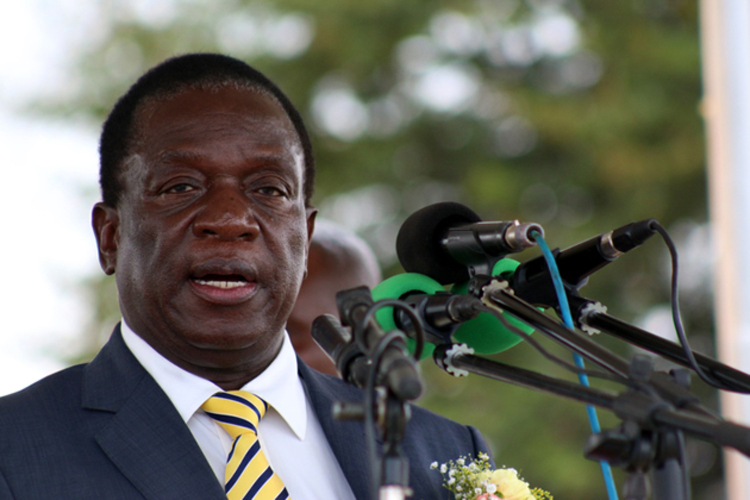
The Sunday Mail

Livingstone Marufu
THE Command Agriculture scheme has taken shape across the country with most crops doing well and at different levels of growth.The programme, meant to establish a vibrant agriculture scheme, comes after the country spent US$253,5 million on importing grain to feed vulnerable communities that were affected by the drought last season.
Consequently, the Government through the Acting President Emmerson Mnangagwa, is monitoring the progression of the programme to ensure its success and reduce the country’s grain import bill.
In an interview with The Sunday Mail last week; Agriculture, Mechanisation and Irrigation Development Minister Dr Joseph Made said, “The targeted command agriculture scheme has taken shape across the country, with most crops nearing the knee level.
“We are happy with the progress made so far as only very few hectares are still at the germination stage. “The Government has provided farmers with the required seeds, basal fertilisers and herbicides.
“We have engaged the central bank to make sure that top dressing fertilizers come in time before the majority of farmers require them. “I am happy with the support that the Chinese government has given us so far. “They already gave us 10 000 tonnes of Urea fertiliser, which is a timely boost for farmers.”
While presenting the 2017 National Budget Finance and Economic Development Minister Patrick Chinamasa said the programme was going on well across all subscribed areas.
“Prioritisation of maize production has been scaled up following two successive droughts which drained the fiscus through grain importation to provide for the national grain requirement shortfall.
“Consequently, starting with the 2016/2017 agricultural season, Government has taken a deliberate stance to increase grain production to levels sufficient to meet national requirements.
“This is being implemented through the Special Maize Production Programme.”
He went on, “The programme is progressing well, with 33 931 farmers contracted having received 76 percent of their maize seed supply, 38 percent of compound D, 3 percent of lime and 20 percent of fuel as at 6 December 2016.
“With regards to tillage, as of 6 December 2016, (at least) 135 260 ha (hectares) had been tilled, with 33 932 ha planted.
“In terms of financing, a total of US$160 million has already been mobilised for the programme, with US$85, 5 million going towards irrigated land and US$75 million for dry land.
“In 2017, US$87,5 million is provided for both irrigable and dry land activities. “In order to sustain the implementation of this programme on a revolving basis, beneficiaries under this Programme will be monitored to produce in line with their contract obligations.”
The 2017 National Budget prioritised agriculture with a total allocation of US$291,6 million.
Of the amount, US$112,5 million will go towards the strategic grain reserve, US$102 million for input schemes and US$47,3 million towards supportive personnel/employment costs.
The farming operations will take US$8 million, irrigation development will use US$6,1 million, extension services will chew US$3,385 million and veterinary services will consume US$2,68 million, among others.
The allocation, together with other agriculture related expenditures incurred during 2016 amounting to US$148,8 million translates into total agricultural support towards the 2016/17 season of US$440,4 million.
The level of support is in line with the 2003 Maputo Declaration by African Heads and Governments on committing at least 10 percent of national budgetary resources to the sector.
Acting President Mnangagwa, who is the chair of the Food and Nutrition committee, urged farmers to take the programme seriously as it was implemented on a cost-recovery basis.
He said some farmers in Manicaland and Mashonaland East provinces were arrested for abusing crop inputs under the specialised Command Agriculture scheme as Government tightens supervision to ensure the success of the programme.
Last week, the Acting President said prosecution is the best way to deal with such malcontents.
“The Command Agriculture is cost-recovery.
“Suppose you have 100 hectares of land and you want to put it under our programme, we know how much seed you will need for those 100 hectares.
“We know how much you need. “We know how much fertiliser you will need on 100 hectares of land, again depending on your ecological region. “We know how much pesticide you need.”
He said 479 000 hectares were put under Command Agriculture against a Government target of 400 000 hectares.
He posited that the Command Agriculture scheme was funded locally, a clear testimony that the country has the potential to transform its economy.
Zimbabwe Commercial Farmers Union (ZCFU) president, Mr Wonder Chabikwa, said he is happy with the progress so far. However, he said more still needs to be done to enable farmers to lend.
“We are moving in the right direction with Command Agriculture but inputs distribution should be improved to ensure that top dressing fertilizer is available on time.
“I have said it before and I continue to say it, financial institutions should extend their credit lines to farmers at a reasonable rate of below 10 percent,” said Mr Chabikwa.
During the 2016/2017 summer cropping season, agriculture is projected to grow by 12 percent driven by higher output from major crops such as maize, cotton and tobacco, as well as dairy production.



